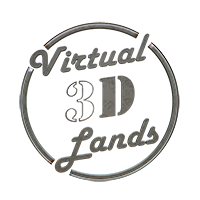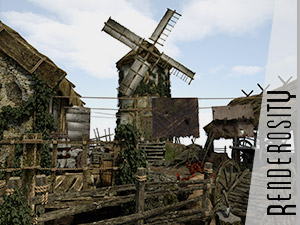Bryce vs Vue
I have used Bryce for a long time before switching - somewhat reluctantly - to Vue. My first tests in Vue were no more than a cautious exploration, but I quickly realized that it had lots of features I had been wanting in Bryce for years. This article is an attempt to summarize my findings in this respect.
Bryce and Vue from the start
Bryce and Vue are 3d landscape programs that can actually be used to make almost any kind of image. They are centered around scene building and rendering. Their modelling capacities are limited, but they are both able to import a wide range of 3d model formats, including Poser files.
In fact, Bryce and Vue have a lot in common. They probably share more features that any other 3d application has. Here are a few:
- Scene navigation buttons
- Small scene preview render (nano preview)
- Infinite planes object (ground, water, clouds)
- Stone generator
- Terrain editor
- Sky editor
- Procedural texture engine
The main difference: Bryce product history
While Vue had a more or less linear development, with significant features being added with every version, the evolution of Bryce has slowed down considerably since Metacreations dropped it in December 1999. Bryce was then sold to Corel, which merely added a tree editor and other goodies to it. It was then sold to DAZ. Its new owner had to revamp its outdated code and added a few interesting features in version 6 (mainly IBL lighting).
The evolution of these programs explains the fact that they now have quite different feature sets. The other big difference is the pricing and product range. Bryce is still one product while Vue is split in a whole range of different products.
Pricing comparison
| Bryce 6 | Vue 7 |
|---|---|
| $ 69.97 | Pioneer: Free |
Historically, Bryce was more expensive than it is now. I remember paying more than $300 for Bryce 2.
E-On Software raised the prices of Vue 7 (compared to Vue 6) but does occasional promotions.
This price difference has to be kept in mind when comparing the features.
Feature comparison
This chart compares the features of Vue 7 Infinite and Bryce 6.1. I have chosen to compare the versions I use, rather than extrapolate on others.
The chart only lists the unique features of each application. Shared features do not appear. Important features appear in red.
I did not detail the animation features, as I do not know them thouroughly.
| Bryce features | Vue features | |
|---|---|---|
| Scene preview | Efficient adaptative degradation Customizable level of detail No flickering in scene preview Quick switch between last render and scene preview Wireframe shadows Wireframe depth preview Flyaround preview | 4 views or 1 viewport modes Frame object in viewports Zooming in viewports Polygon highlighting in texture shaded mode Atmosphere elements preview Accurate element color preview Adaptative level of details with procedural terrains View through spot lights Safe frame previews |
| Scene handling | Quick select by object type Quickly isolate current object | Organize objects by layers Layer or individual object visibility Object listing in side panel Material listing Texture maps listing Object gizmos (move, rotate, resize) Any number of cameras Cameras field of view in mm Fixed camera height (relative to terrain) Smart object drop |
| Lights and shadows | Preview light effect in scene Round parallel light | Light panels Light emitting objects Lens flares Shadow maps |
| Terrains | 27 terrain styles (some quite elaborate) Fine terrain previews Accurate filter power adjustements Accurate terrain edge edition Efficient terrain filters (subcontours, sawtooth, etc.) | 8 terrain styles (fairly basic) Function driven procedural terrains Detailed edition of terrain functions Additional terrain effects (pebbles, stones, craters) "Infinite" terrains |
| Materials | Material preview with actual atmosphere Material preview on actual object Rotate around material in preview | Mix any number of materials Use any number of material layers Very detailed function editor affecting every aspect of a material Subsurface scattering Displacement mapping Displacements can be baked to object Fade out colors Blurred reflections adjustement in material panel Glowing materials Memorize colors |
| Vegetation | About 75 plant presets, some of them not very realistic Trees with roots and realistic joints | 160 SolidGrowth plant models (60 plants only in Vue Complete) Generate ground plants and trees from preset models Detailed edition of plant parts Detailed materials for every plant part Automatic variations between individual plants Ecosystem feature enabling to cover areas with plants (and other models) Dynamic plant population Paint object ecosystems on terrains or objects, from any view Plant export |
| Atmosphere | Two types of atmospheres (standard, IBL) Preview atmosphere in scene | 4 types of atmospheric models (Standard, Volumetric, Spectral, IBL) Very realistic spectral atmosphere model Detailed volumetric clouds God rays Sun / moon visible in viewports. Handled like objects. Add more than one sun Background planets Adjustable light balance (ambient / sky) Any number of cloud layers Wind and breeze Ventilator objects (local wind) |
| Modelling tools | 3d text Dynamic subdivision on rocks Decimate objects Bake primitives to polygons Complete objects export | |
| Rendering | Very good antialiasing Good default render quality Easy render quality adjustment Easy to use plop render Spray rendering | Ambient occlusion Global illumination Radiosity Post render options: natural film response, auto exposure Industry standard image aspect ratios |
You can see from the list above that Vue clearly has the edge in terms of number of features. Some of the features are very significant improvements over what Bryce can propose. But to me, Bryce still has advantages in terms of ergonomy and a nicer interface and scene preview. Vue improved its scene preview significantly in V7, adding antialiased lines for instances, but it is still not on par with Bryce in that respect.

